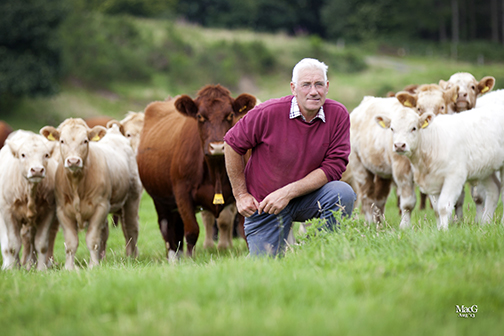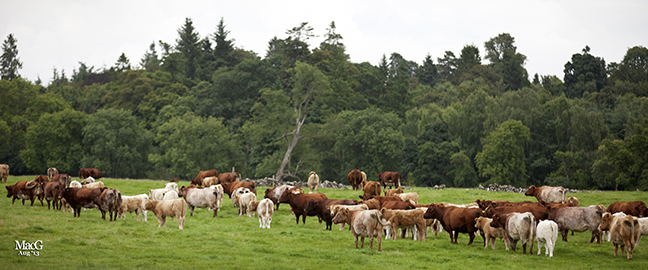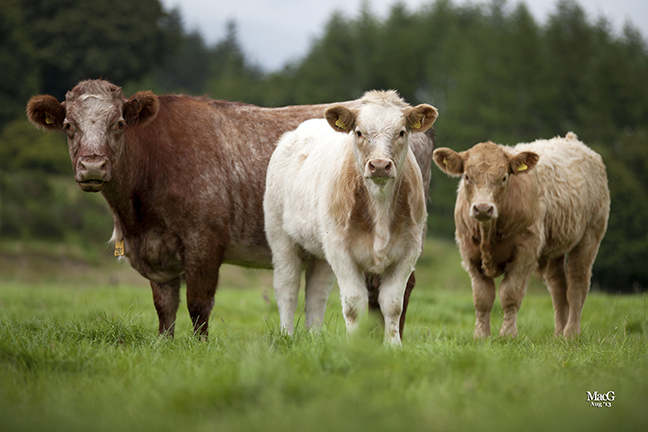Charolais + Beef Shorthorn cross to maximise output

What does it take for a sustainable future for a suckler cow enterprise? According to SAC beef specialist Ian Pritchard, the answer lies in maximising output per unit of her body weight. That means accurately matching cow type to environmental conditions before selecting the correct terminal sire to drive profits with minimal inputs.
“Suckler keepers need to evaluate the cow type they keep and check that they are ‘pulling their weight’; there is no room for passengers,” he said.
Mr Pritchard judged the Morrisons Beef Shorthorn Suckler Herd of the Year Award 2012 and found among his finalists Iain and Sarah Malcolm, who he says were farming an exemplary herd by maximising output from their own resources complemented by huge attention to detail.
The Malcolm’s Callander, Perthshire based Beef Shorthorn cross herd achieved a minimum rearing percentage of 91%, a tight bulling period of eight weeks with 100% calving outdoors on target and 74% within the first three weeks. In addition, calves were reared to a profitable sale weight with a daily liveweight gain of 1.2kg per day from milk and grass alone, creep was introduced in the last fortnight before weaning at six months. “In a difficult year like 2012, performance had to be good – this farm, as usual, had to sell all of the calves shortly after weaning.” Steers averaged 275kg and £620, and heifers, 265kg and £580, and were within the top 10% through Stirling and Oban markets.
Mr Malcolm together with his wife Sarah and sons, Angus and Jack, runs the 2,700 acre hill unit at Cromlix and Coilechat, incorporating a 170 cow commercial herd, the majority of which Beef Shorthorn cross Highland, with over 50% put to the Charolais terminal sire. Mr Malcolm explained: “Historically we have retained homebred Beef Shorthorn cross heifers, but recently changed policy to buying in replacements in order to introduce the best of the breed’s maternal traits that maximise margins on the less favoured grazing. We certainly don’t keep them for fun, they have to be commercial and pay their way.”
The ability to efficiently convert grass thereby minimising concentrates input is crucial to a successful suckler strategy, explained Mr Pritchard: “Cows need to forage well, utilising variable quality forage, and putting condition on in the summer months to take them through the winter.” The Malcolm’s unit is exemplary. Mr Malcolm said: “The sucklers form a grazing rotation alongside our complementary flock of 1,000 ewes to make the most of the poorer grassland, staying on the in-by from calving until weaning in mid-September. Come November, they go back up to the hill ground. We don’t grow any forage crops or feed hay, with cows outwintering on hill grazing supplemented with an average 490kg per head of bought in concentrate rolls. They come down on to in-by to calve from mid-March.”
The herd’s all year round foraging ability has also brought massive savings to the Malcolm’s fixed costs. Machinery and equipment and subsequent depreciation costs have been minimised to one 80hp tractor, grass topper, lime spreader, direct drill, post driver and three quad bikes. Outwintering the herd means no investment in accommodation has been required.
As well as selecting Beef Shorthorn cross heifers for key maternal traits, Mr Malcolm maintains that using estimated breeding values (EBVs) to choose high performing continental terminal sires is essential to seeing returns. “We select Charolais bulls for calving ease first and foremost, coupled with the visuals of length, height and a rangey frame to produce larger framed, shapely calves out of our compact cows that are fast growing and with unbeatable weight for age.”
Maintaining herd health also features in the strategy. Outwintering helps to improve overall status and the herd is currently tested BVD and is Johne’s free. Cows average eight crops of calves before they are moved on. “I’m confident that we could keep them for longer if this wasn’t such an extensive unit.”
• The Malcolm family is hosting an open day on 13 September organised by the Beef Shorthorn Society, British Charolais Cattle Society, Highland Cattle Society, NFUS and SRUC.


Beef Shorthorn cross Highland suckler cows with
Charolais cross calves at Cromlix.
Categories: Commercial, News
Trefonnen Charolais Dispersal Sale 7th November 2013 » « Ralph Needham elected Charolais president